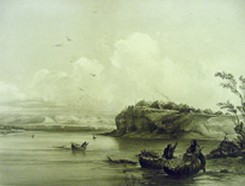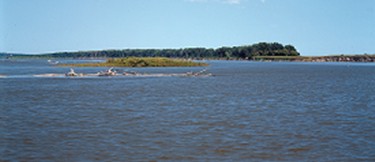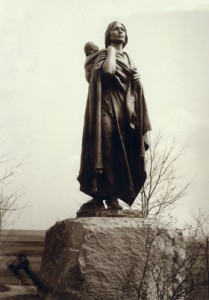 |
| Return to Home | Unit 2 |
 |
|
Lesson 4 The Corps of Discovery left present-day South Dakota on October 14. They moved on to what is now North Dakota. They came to a large Mandan Indian village. It was November. The men had been on the trip for 164 days. They had gone 1,600 miles. At that time, 4,500 people lived in the Mandan village. In fact, more people lived there than in Washington, D.C. The Mandans were farmers. They traded their crops to other tribes. They traded for horses and buffalo robes. Their village was a trading center. Tribes from up and down the Missouri River came there. The Corps of Discovery built a fort nearby. They lived there during the winter. Lewis and Clark named it Fort Mandan in honor of their new friends. During the winter, they hired Toussaint Charbonneau as an interpreter. He was a French-Canadian fur trader. His wife was a Shoshone Indian. Her name was Sacagawea. She had a baby boy. His name was Jean Baptiste.
|
 Mandan Indian Village |
 Missouri River Today |
In the spring, some explorers went back down the Missouri River. They took plants and animals to Saint Louis. The rest of the men went up the Missouri River. Sacagawea and her son went with them. Now they were going into lands that had not been mapped. The Mandan village was the last point on the river that fur traders knew. When Indian tribes saw Sacagawea and her son, they did not worry. A woman and child with the expedition was a sign of peace. Most tribes greeted Lewis and Clark as friends. Sacagawea was helpful to the corps just by being along. She also helped by knowing landmarks and the Shoshone language. She saved papers and supplies when a boat filled with water. The corps was then in present-day Montana. |
|
Not until November of 1805 did the Corps of Discovery reach its goal. The men saw the Pacific Ocean at last. They built a small fort in present-day Oregon. They named it for the Clatsop Indians. They moved into Fort Clatsop on Christmas day. They explored the surrounding country while waiting for spring. A group of men went to the seacoast to make salt. Lewis and Clark had a lot of time to write in their journals. Their writings and the maps they drew were among the most important products of the expedition. The corps left for home in March of 1806. In August, they were back at the Mandan village. They said good-bye to Sacagawea and her family. Two years after they first came to South Dakota, the corps was there again. The explorers were floating down the Missouri River fast. They went up to seventy miles each day. They quickly left South Dakota behind.
|
 Sacagawea Statue |
The Corps of Discovery’s adventure was over. They were back in Saint Louis. Lewis and Clark had mapped new lands. They had written about interesting plants and animals. They had made friends with most of the Indians they met. The expedition opened the door for more Americans to go west and settle. |